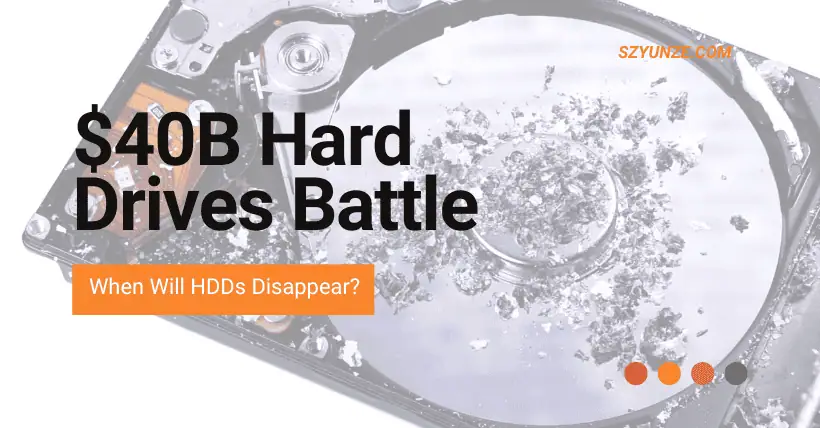The fate of an entire industry rests on a laser smaller than a grain of salt.
Data storage company Seagate has developed this tiny heat source to encode more and more information onto the spinning disks of HDDs.
Data centers house thousands of HDDs, storing everything from home movies to medical records to factory log files.
Seagate’s innovative Heat-Assisted Magnetic Recording (HAMR) technology is critical for the future.
Seagate’s HDDs are competing with newer, faster technologies in the global information storage sector. To survive, storage capacity must keep increasing.
A newly released HDD, about the size of a paperback book, offers a capacity of 36TB—equivalent to 1,400 Blu-ray movies.
In the lab, capacities nearly twice that amount have already been achieved, and Seagate believes there is even greater potential.
Seagate CEO Dave Mosley stated, “We’ve always believed in the vast potential of the HDD market.”
Continuous investment and its resulting returns have proven this belief.
As AI drives a surge in data storage demand, new products are emerging.
IDC estimates that data centers spent $40 billion on storage devices last year, with a projected 31% increase over the next two years.
Analysts predict that Seagate’s revenue will grow by 55% from fiscal year 2024 to 2026, reaching $10 billion, while earnings per share are expected to rise by over 650%.
IBM invented the hard drive in the 1950s, and it has persisted while other storage media—such as punch cards, floppy disks, and CD-ROMs—have faded from use.
Hard drive capacities have grown as prices have fallen.
Today, a 1TB consumer HDD costs less than $70 and can store tens of thousands of high-resolution photos.
In the 1990s, HDDs encountered their most formidable challenger.
SSDs store data electronically and offer faster read and write speeds than HDDs.
Per terabyte, SSDs are more expensive than HDDs, but the price gap is narrowing.
SSDs have become the default storage for personal computers, and industry insiders believe they will eventually dominate data centers as well.
John Colgrove, founder of storage system design company Pure Storage, stated that they are currently selling a 150TB DirectFlash SSD.
In the next two years, capacity is expected to quadruple. This increase, combined with SSDs’ lower power consumption, will rapidly erode HDDs’ cost advantage.
The debate is not about whether HDDs will disappear, but when.
Seagate has managed to shrink bits smaller and smaller, but traditional HDDs are nearing a physical limit—beyond which data would become too unstable to control.
Seagate has been developing HAMR technology for over 20 years.
The new drives use lasers to apply a nanosecond-long heat pulse to smaller bits than ever before, enabling precise magnetic manipulation.
The read/write heads responsible for recording information are manufactured at Seagate’s factory in suburban Minneapolis.
Workers, clad in masks, gloves, and hooded coveralls, operate machinery to deposit or etch layers of material onto 8-inch ceramic wafers.
The entire room is bathed in yellow lighting to prevent interference with the photosensitive chemicals used in the process.
Each wafer contains 100,000 magnetic heads, which workers transport between workstations in lunchbox-sized containers.
Once completed, the wafers are airlifted to Thailand, where other teams install the lasers and assemble the drives.
Seagate reports that two major cloud computing customers have each ordered 1 exabyte (EB) of HAMR storage, equivalent to tens of thousands of HDDs.
Western Digital CEO Irving Tan stated that HAMR drives could eventually reach 100TB. Beyond that, technologies still in development may take the lead.
One such technology is known as Heat-Assisted Magnetic Recording (HAMR), which enables writing on even smaller grains.
According to IDC, HDDs currently account for more than 80% of data center storage, but SSDs continue to gain ground.
Some data centers prioritize SSDs as customers demand high-speed performance.
However, not all operations require SSD-level speeds.
For certain functions—such as archiving, backups, or similar tasks—retrieval speed is less important than sheer storage capacity.
IDC predicts that by 2028, HDDs will still cost only one-fifth as much as SSDs per terabyte.
Data center spending on HDDs is expected to reach $22 billion, a 69% increase from 2024, though still below the projected $32 billion for SSDs.
Analysts point out that current SSD manufacturing capacity is insufficient to fully replace HDDs.
This reality alone ensures that HDDs will continue to exist for some time.
They aren’t the fastest, smallest, or most powerful storage solution—but they offer a cost-effective way to retain large amounts of data for extended periods.
Source: Internet
Related:

Disclaimer:
- This channel does not make any representations or warranties regarding the availability, accuracy, timeliness, effectiveness, or completeness of any information posted. It hereby disclaims any liability or consequences arising from the use of the information.
- This channel is non-commercial and non-profit. The re-posted content does not signify endorsement of its views or responsibility for its authenticity. It does not intend to constitute any other guidance. This channel is not liable for any inaccuracies or errors in the re-posted or published information, directly or indirectly.
- Some data, materials, text, images, etc., used in this channel are sourced from the internet, and all reposts are duly credited to their sources. If you discover any work that infringes on your intellectual property rights or personal legal interests, please contact us, and we will promptly modify or remove it.



